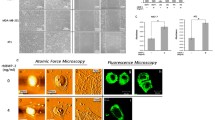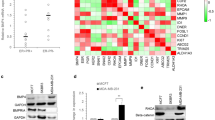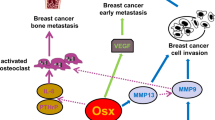Abstract
Bone-morphogenetic proteins (BMPs) play an important role in development and many cellular processes. However, their functional role in the development and progression of breast cancer is not clearly understood. In the present study, we performed a systematic expression analysis of the 14 types of BMPs in 10 human breast cancer cell lines. We found that bone morphogenetic protein 4 (BMP4) was one of the most frequently expressed BMPs. Furthermore, the expression level of BMP4 was maybe correlated with the metastatic potential of the cancer lines. Accordingly, overexpression of BMP4 in the breast cancer cell lines MCF-7 and MBA-MD-231 promoted the migration and invasion phenotypes of the cancer cells, whereas RNAi-mediated knockdown of BMP4 expression inhibited the migration and invasion activities of the cancer cells. To identify the important factors that may mediate the BMP4 functions in breast cancer cells, we analyzed a panel of cancer-related genes, and found that the expression of matrix metalloproteinase-1 (MMP-1) and C-X-C chemokine receptor type 4 (CXCR4) sharply increased at both the mRNA and protein levels in the breast cancer cells overexpressing BMP4. Interestingly, when breast cancer cells MDA-MB-231 or MCF-7 were co-cultured with the osteoblast-like cells MG63 to mimic a bone metastasis microenvironment, BMP4 did not exhibit any significant effect on the expression of OPG or RANKL, two important factors in bone remodeling. BMPs antagonists, Noggin, parallel inhibited breast cancer cell migration and invasion and induced bone remodeling. Taken together, our results strongly suggest that BMP4 may promote the migration and invasion of breast cancer cells, at least in part by up-regulating the expressions of MMP-1 and CXCR4. It is conceivable that novel therapeutics for breast cancer may be developed by targeting BMP4 signaling pathway and/or its important downstream mediators in breast cancer cells.





Similar content being viewed by others
Abbreviations
- BMP4:
-
Bone morphogenetic proteins 4
- MMP-1:
-
Matrix metalloproteinase-1
- CXCR4:
-
C-X-C chemokine receptor type 4
- CXCL12:
-
Chemokine (C-X-C motif) ligand 12, SDF-1
- OPG:
-
Osteoprotegerin
- RANKL:
-
Receptor activator of NF-kB ligand
- GFP:
-
Green fluorescent protein
- RFP:
-
Red fluorescent protein
- RT-PCR:
-
Reverse transcriptase-polymerase chain reaction
- qPCR:
-
Real-time quantitative PCR
References
Plunkett TA, Smith P, Rubens RD (2000) Risk of complications from bone metastases in breast cancer—implications for management. Eur J Cancer 36:476–482
Wozney JM (2002) Overview of bone morphogenetic proteins. Spine (Phila Pa 1976) 27:S2–S8
Hogan BL (1996) Bone morphogenetic proteins: multifunctional regulators of vertebrate development. Genes Dev 10:1580–1594
Alarmo E-L, Kuukasjärvi T, Karhu R, Kallioniemi A (2006) A comprehensive expression survey of bone morphogenetic proteins in breast cancer highlights the importance of BMP4 and BMP7. Breast Cancer Res Treat 103:239–246. doi:10.1007/s10549-006-9362-1
Katsuno Y, Hanyu A, Kanda H, Ishikawa Y, Akiyama F, Iwase T, Ogata E, Ehata S, Miyazono K, Imamura T (2008) Bone morphogenetic protein signaling enhances invasion and bone metastasis of breast cancer cells through Smad pathway. Oncogene 27:6322–6333. doi:10.1038/onc.2008.232
Helms MW, Packeisen J, August C, Schittek B, Boecker W, Brandt BH, Buerger H (2005) First evidence supporting a potential role for the BMP/SMAD pathway in the progression of oestrogen receptor-positive breast cancer. J Pathol 206:366–376. doi:10.1002/path.1785
Clement JH, Raida M, Sanger J, Bicknell R, Liu J, Naumann A, Geyer A, Waldau A, Hortschansky P, Schmidt A, Hoffken K, Wolft S, Harris AL (2005) Bone morphogenetic protein 2 (BMP-2) induces in vitro invasion and in vivo hormone independent growth of breast carcinoma cells. Int J Oncol 27:401–407
Raida M, Clement JH, Leek RD, Ameri K, Bicknell R, Niederwieser D, Harris AL (2005) Bone morphogenetic protein 2 (BMP-2) and induction of tumor angiogenesis. J Cancer Res Clin Oncol 131:741–750. doi:10.1007/s00432-005-0024-1
Du J, Yang S, An D, Hu F, Yuan W, Zhai C, Zhu T (2009) BMP-6 inhibits microRNA-21 expression in breast cancer through repressing deltaEF1 and AP-1. Cell Res 19:487–496. doi:10.1038/cr.2009.34
Yang S, Du J, Wang Z, Yuan W, Qiao Y, Zhang M, Zhang J, Gao S, Yin J, Sun B, Zhu T (2007) BMP-6 promotes E-cadherin expression through repressing delta EF1 in breast cancer cells. BMC Cancer 7:211. doi:10.1186/1471-2407-7-211
Yang S, Du J, Wang Z, Yan J, Yuan W, Zhang J, Zhu T (2009) Dual mechanism of δEF1 expression regulated by bone morphogenetic protein-6 in breast cancer. Int J Biochem Cell Biol 41:853–861. doi:10.1016/j.biocel.2008.08.030
Ye L, Bokobza S, Li J, Moazzam M, Chen J, Mansel RE, Jiang WG (2010) Bone morphogenetic protein-10 (BMP-10) inhibits aggressiveness of breast cancer cells and correlates with poor prognosis in breast cancer. Cancer Sci 101:2137–2144. doi:10.1111/j.1349-7006.2010.01648.x
Hanavadi S, Martin TA, Watkins G, Mansel RE, Jiang WG (2007) The role of growth differentiation factor-9 (GDF-9) and its analog, GDF-9b/BMP-15, in human breast cancer. Ann Surg Oncol 14:2159–2166. doi:10.1245/s10434-007-9397-5
Cheng H, Jiang W, Phillips FM, Haydon RC, Peng Y, Zhou L, Luu HH, An N, Breyer B, Vanichakarn P, Szatkowski JP, Park JY, He TC (2003) Osteogenic activity of the fourteen types of human bone morphogenetic proteins (BMPs). J Bone Joint Surg Am 85-A:1544–1552
Kang Q, Sun MH, Cheng H, Peng Y, Montag AG, Deyrup AT, Jiang W, Luu HH, Luo J, Szatkowski JP, Vanichakarn P, Park JY, Li Y, Haydon RC, He TC (2004) Characterization of the distinct orthotopic bone-forming activity of 14 BMPs using recombinant adenovirus-mediated gene delivery. Gene Ther 11:1312–1320. doi:10.1038/sj.gt.3302298
He TC, Zhou S, da Costa LT, Yu J, Kinzler KW, Vogelstein B (1998) A simplified system for generating recombinant adenoviruses. Proc Natl Acad Sci USA 95:2509–2514
Luo J, Deng ZL, Luo X, Tang N, Song WX, Chen J, Sharff KA, Luu HH, Haydon RC, Kinzler KW, Vogelstein B, He TC (2007) A protocol for rapid generation of recombinant adenoviruses using the AdEasy system. Nat Protoc 2:1236–1247. doi:10.1038/nprot.2007.135
Luo Q, Kang Q, Song WX, Luu HH, Luo X, An N, Luo J, Deng ZL, Jiang W, Yin H, Chen J, Sharff KA, Tang N, Bennett E, Haydon RC, He TC (2007) Selection and validation of optimal siRNA target sites for RNAi-mediated gene silencing. Gene 395:160–169. doi:10.1016/j.gene.2007.02.030
Su Y, Luo X, He BC, Wang Y, Chen L, Zuo GW, Liu B, Bi Y, Huang J, Zhu GH, He Y, Kang Q, Luo J, Shen J, Chen J, Jin X, Haydon RC, He TC, Luu HH (2009) Establishment and characterization of a new highly metastatic human osteosarcoma cell line. Clin Exp Metastasis 26:599–610. doi:10.1007/s10585-009-9259-6
Bi Y, Huang J, He Y, Zhu GH, Su Y, He BC, Luo J, Wang Y, Kang Q, Luo Q, Chen L, Zuo GW, Jiang W, Liu B, Shi Q, Tang M, Zhang BQ, Weng Y, Huang A, Zhou L, Feng T, Luu HH, Haydon RC, He TC, Tang N (2009) Wnt antagonist SFRP3 inhibits the differentiation of mouse hepatic progenitor cells. J Cell Biochem 108:295–303. doi:10.1002/jcb.22254
Fidler IJ (2003) The pathogenesis of cancer metastasis: the ‘seed and soil’ hypothesis revisited. Nat Rev Cancer 3:453–458. doi:10.1038/nrc1098
Wang X, Lu H, Urvalek AM, Li T, Yu L, Lamar J, Dipersio CM, Feustel PJ and Zhao J (2010) KLF8 promotes human breast cancer cell invasion and metastasis by transcriptional activation of MMP9. Oncogene. doi:10.1038/onc.2010.563
Sapkota D, Bruland O, Costea DE, Haugen H, Vasstrand EN and Ibrahim SO (2010) S100A14 regulates the invasive potential of oral squamous cell carcinoma derived cell-lines in vitro by modulating expression of matrix metalloproteinases, MMP1 and MMP9. Eur J Cancer. doi:10.1016/j.ejca.2010.10.012
Dewan MZ, Ahmed S, Iwasaki Y, Ohba K, Toi M, Yamamoto N (2006) Stromal cell-derived factor-1 and CXCR4 receptor interaction in tumor growth and metastasis of breast cancer. Biomed Pharmacother 60:273–276. doi:10.1016/j.biopha.2006.06.004
Shepherd TG, Theriault BL, Nachtigal MW (2008) Autocrine BMP4 signalling regulates ID3 proto-oncogene expression in human ovarian cancer cells. Gene 414:95–105. doi:10.1016/j.gene.2008.02.015
Theriault BL, Shepherd TG, Mujoomdar ML, Nachtigal MW (2007) BMP4 induces EMT and Rho GTPase activation in human ovarian cancer cells. Carcinogenesis 28:1153–1162. doi:10.1093/carcin/bgm015
Piccirillo SG, Reynolds BA, Zanetti N, Lamorte G, Binda E, Broggi G, Brem H, Olivi A, Dimeco F, Vescovi AL (2006) Bone morphogenetic proteins inhibit the tumorigenic potential of human brain tumour-initiating cells. Nature 444:761–765. doi:10.1038/nature05349
Rothhammer T, Bataille F, Spruss T, Eissner G, Bosserhoff AK (2007) Functional implication of BMP4 expression on angiogenesis in malignant melanoma. Oncogene 26:4158–4170. doi:10.1038/sj.onc.1210182
Hjertner O, Hjorth-Hansen H, Borset M, Seidel C, Waage A, Sundan A (2001) Bone morphogenetic protein-4 inhibits proliferation and induces apoptosis of multiple myeloma cells. Blood 97:516–522
Malemud CJ (2006) Matrix metalloproteinases (MMPs) in health and disease: an overview. Front Biosci 11:1696–1701. doi:10.2741/1915
Hanemaaijer R, Verheijen JH, Maguire TM, Visser H, Toet K, McDermott E, O’Higgins N, Duffy MJ (2000) Increased gelatinase-A and gelatinase-B activities in malignant vs. benign breast tumors. Int J Cancer 86:204–207. doi:10.1002/(SICI)1097-0215(20000415)86:2<204:AID-IJC9>3.0.CO;2-6
London CA, Sekhon HS, Arora V, Stein DA, Iversen PL, Devi GR (2003) A novel antisense inhibitor of MMP-9 attenuates angiogenesis, human prostate cancer cell invasion and tumorigenicity. Cancer Gene Ther 10:823–832. doi:10.1038/sj.cgt.7700642
Riedel F, Gotte K, Schwalb J, Bergler W, Hormann K (2000) Expression of 92-kDa type IV collagenase correlates with angiogenic markers and poor survival in head and neck squamous cell carcinoma. Int J Oncol 17:1099–1105
Scorilas A, Karameris A, Arnogiannaki N, Ardavanis A, Bassilopoulos P, Trangas T, Talieri M (2001) Overexpression of matrix-metalloproteinase-9 in human breast cancer: a potential favourable indicator in node-negative patients. Br J Cancer 84:1488–1496. doi:10.1054/bjoc.2001.1810
Wyatt CA, Geoghegan JC, Brinckerhoff CE (2005) Short hairpin RNA-mediated inhibition of matrix metalloproteinase-1 in MDA-231 cells: effects on matrix destruction and tumor growth. Cancer Res 65:11101–11108. doi:10.1158/0008-5472.CAN-05-2446
Daniele A, Zito AF, Giannelli G, Divella R, Asselti M, Mazzocca A, Paradiso A, Quaranta M (2010) Expression of metalloproteinases MMP-2 and MMP-9 in sentinel lymph node and serum of patients with metastatic and non-metastatic breast cancer. Anticancer Res 30:3521–3527
Stankovic S, Konjevic G, Gopcevic K, Jovic V, Inic M, Jurisic V (2010) Activity of MMP-2 and MMP-9 in sera of breast cancer patients. Pathol Res Pract 206:241–247. doi:10.1016/j.prp.2009.12.003
Kang Y, Siegel PM, Shu W, Drobnjak M, Kakonen SM, Cordon-Cardo C, Guise TA, Massague J (2003) A multigenic program mediating breast cancer metastasis to bone. Cancer Cell 3:537–549
Minn AJ, Gupta GP, Siegel PM, Bos PD, Shu W, Giri DD, Viale A, Olshen AB, Gerald WL, Massague J (2005) Genes that mediate breast cancer metastasis to lung. Nature 436:518–524. doi:10.1038/nature03799
Hassan S, Ferrario C, Saragovi U, Quenneville L, Gaboury L, Baccarelli A, Salvucci O, Basik M (2009) The influence of tumor-host interactions in the stromal cell-derived factor-1/CXCR4 ligand/receptor axis in determining metastatic risk in breast cancer. Am J Pathol 175:66–73. doi:10.2353/ajpath.2009.080948
Liang Z, Wu H, Reddy S, Zhu A, Wang S, Blevins D, Yoon Y, Zhang Y, Shim H (2007) Blockade of invasion and metastasis of breast cancer cells via targeting CXCR4 with an artificial microRNA. Biochem Biophys Res Commun 363:542–546. doi:10.1016/j.bbrc.2007.09.007
Li HY, Ren GS, Tan JX (2009) Effect of small interfering RNA targeting CXCR4 on breast cancer angiogenesis. Nan Fang Yi Ke Da Xue Xue Bao 29:954–958
Li HY, Ren GS, Tan JX (2009) The effects of shRNA-CXCR4 on breast cancer cells migration and invasion. Sichuan Da Xue Xue Bao Yi Xue Ban 40:393–397
Richert MM, Vaidya KS, Mills CN, Wong D, Korz W, Hurst DR, Welch DR (2009) Inhibition of CXCR4 by CTCE-9908 inhibits breast cancer metastasis to lung and bone. Oncol Rep 21:761–767
Huang EH, Singh B, Cristofanilli M, Gelovani J, Wei C, Vincent L, Cook KR, Lucci A (2009) A CXCR4 antagonist CTCE-9908 inhibits primary tumor growth and metastasis of breast cancer. J Surg Res 155:231–236. doi:10.1016/j.jss.2008.06.044
Mizell J, Smith M, Li BD, Ampil F, Chu QD (2009) Overexpression of CXCR4 in primary tumor of patients with HER-2 negative breast cancer was predictive of a poor disease-free survival: a validation study. Ann Surg Oncol 16:2711–2716. doi:10.1245/s10434-009-0551-0
Andre F, Xia W, Conforti R, Wei Y, Boulet T, Tomasic G, Spielmann M, Zoubir M, Berrada N, Arriagada R, Hortobagyi GN, Hung MC, Pusztai L, Delaloge S, Michiels S, Cristofanilli M (2009) CXCR4 expression in early breast cancer and risk of distant recurrence. Oncologist 14:1182–1188. doi:10.1634/theoncologist.2009-0161
Hiller DJ, Li BD and Chu QD (2010) CXCR4 as a predictive marker for locally advanced breast cancer post-neoadjuvant therapy J Surg Res (1). doi:10.1016/j.jss.2010.04.045
Holm NT, Abreo F, Johnson LW, Li BD, Chu QD (2009) Elevated chemokine receptor CXCR4 expression in primary tumors following neoadjuvant chemotherapy predicts poor outcomes for patients with locally advanced breast cancer (LABC). Breast Cancer Res Treat 113:293–299. doi:10.1007/s10549-008-9921-8
Chu QD, Holm NT, Madumere P, Johnson LW, Abreo F and Li BD (2010) Chemokine receptor CXCR4 overexpression predicts recurrence for hormone receptor-positive, node-negative breast cancer patients. Surgery. doi:10.1016/j.surg.2010.05.016
Zhao Y, Cai Y, Wang YN (2010) RANKL and OPG regulation on bone remodeling. Shanghai Kou Qiang Yi Xue 19:443–446
Boyce BF, Xing L (2008) Functions of RANKL/RANK/OPG in bone modeling and remodeling. Arch Biochem Biophys 473:139–146. doi:10.1016/j.abb.2008.03.018
Kearns AE, Khosla S, Kostenuik PJ (2008) Receptor activator of nuclear factor kappaB ligand and osteoprotegerin regulation of bone remodeling in health and disease. Endocr Rev 29:155–192. doi:10.1210/er.2007-0014
Gazzerro E, Gangji V, Canalis E (1998) Bone morphogenetic proteins induce the expression of noggin, which limits their activity in cultured rat osteoblasts. J Clin Invest 102:2106–2114. doi:10.1172/JCI3459
Feeley BT, Krenek L, Liu N, Hsu WK, Gamradt SC, Schwarz EM, Huard J, Lieberman JR (2006) Overexpression of noggin inhibits BMP-mediated growth of osteolytic prostate cancer lesions. Bone 38:154–166. doi:10.1016/j.bone.2005.07.015
Feeley BT, Liu NQ, Conduah AH, Krenek L, Roth K, Dougall WC, Huard J, Dubinett S, Lieberman JR (2006) Mixed metastatic lung cancer lesions in bone are inhibited by noggin overexpression and Rank:Fc administration. J Bone Miner Res 21:1571–1580. doi:10.1359/jbmr.060706
Acknowledgments
The authors thank Dr. T.-C. He of The University of Chicago Medical Center for providing the cell lines, vectors, and technical support. The above study was supported by research grants from Chongqing Public Health Bureau (Grant# 2010-2-157, DG) and Chongqing Natural Science Foundation (Grant# 2010BB5100, JYH),China.
Conflict of interest
The authors report no conflicts of interest.
Author information
Authors and Affiliations
Corresponding author
Electronic supplementary material
Below is the link to the electronic supplementary material.
Rights and permissions
About this article
Cite this article
Guo, D., Huang, J. & Gong, J. Bone morphogenetic protein 4 (BMP4) is required for migration and invasion of breast cancer. Mol Cell Biochem 363, 179–190 (2012). https://doi.org/10.1007/s11010-011-1170-1
Received:
Accepted:
Published:
Issue Date:
DOI: https://doi.org/10.1007/s11010-011-1170-1




